These objects can be used to support teaching and learning. They have been grouped into themes. For more information on these see the themes page.
Objects on these pages were used to control, harm and torture. They contain legacies of violence, racism and enslavement. Many are graphic or potentially upsetting.
Africa Before Transatlantic Enslavement
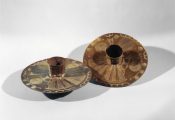
Adala Anklets
These brass anklets are worn in West Africa by young women who are ready to marry, symbolizing the transition from childhood to adulthood. Worn by the Igbo people of Nigeria, they...
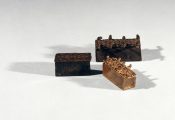
Asante boxes for gold dust
Gold was central to the Asante economy of West Africa and commercial transactions used gold or gold dust. Brass boxes were used for storing gold dust, and great care was taken not...

Asante cosmetic pots
This cosmetic pot is from the Asante people of Ghana. The hammered pattern on the brass pot includes an image of the mythical ‘sankofa’ bird looking backwards while it...

Asante stool
According to legend the Asante empire of Akan-speaking people on the Gold Coast, West Africa, was founded in the 17th century when a golden stool descended from heaven into the lap...
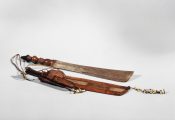
Asante sword and sheath
The red shells used to decorate this Asante sheath suggest it was owned by a person of high rank, as these cowrie shells were imported into Africa from Asia in exchange for gold....
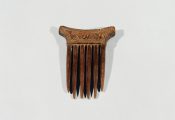
Baule comb
A wooden comb from the Baule ethnic group on the Ivory Coast of Africa. It is carefully carved showing skilled craftsmanship and is 134 mm long.

Bead bracelets
African people cherished beads and appreciated their beauty over the centuries. Glass beads by the million were imported into Africa by Europeans. Those from Venice, Italy, were...
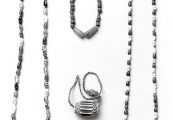
Beads
These are strings of pink and white beads. Glass beads were a regular cargo from England to Africa. In the 1770s they made up between 25% and 50% of the value of cargoes shipped by...

Benin Leopard
This bronze Benin leopard is one of a pair made in about 1950 but characteristic of West African craftsmanship from earlier centuries. The leopard was once the emblem of power for...

Bow lyre
This bow lyre, a type of harp, is made of leather, wood and string and comes from West Africa.
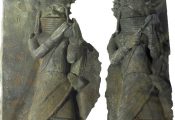
Brass Plaque, Edo Peoples, Benin, Nigeria
Brought from Benin City after it had fallen to the British Expedition of 1897, these plaques decorated the walls of the Oba’s (King’s) palace. The figures represent two...
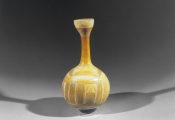
Calabash Bottle
The hollowed-out and dried skins of calabashes or gourds (pumpkin-like plants) were widely used as containers or to make bowls and bottles in parts of Africa, they were also often...

Calabash Guitar
This is a decorated calabash guitar with a bow for playing the single string. A wooden stick forms the neck of the guitar and hanging threads have been added as decoration. It...

Ceremonial Headdress
These ceremonial headdresses are from the Konkomba people in Ghana, and date from the early 20th century. Cowrie shells, imported from the Indian Ocean, were widely used throughout...
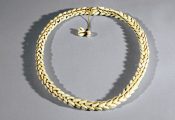
Cowrie-shell belt
This belt from the Congo region of Africa is made from cowrie shells. They are the shells of a mollusc found only in certain areas around the Maldives and other Indian Ocean...

Drum from Haiti
In the French and Spanish islands of the Caribbean, including Haiti (or St Domingue as it was previously known) the religious beliefs of enslaved Africans were adapted to the...
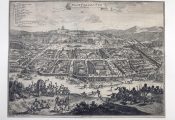
Engraving of the City of Loango
Around 1670. Loango was the centre of a rich and powerful trading kingdom during the 16th and 17th centuries. By the 18th century its rulers had been lured into slave trading. As...
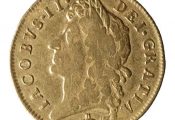
Guinea Coin, 1686
First minted in 1663, the ‘Guinea’, took its name from the West Coast of Africa, from which most of the gold was imported. For a period after the formation of the Royal...
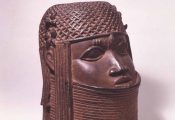
Head of an 'Oba' from the Edo of Benin
This brass head from Benin, West Africa, dates from the mid-to late 16th century. When each Oba (or King) died he had a shrine made in his memory. Brass heads like this were placed...
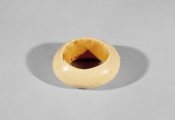
Ivory bracelet
This bracelet is a typical West African ornament made of elephant ivory. It is 101 mm in diameter, having been carved from a slice of elephant tusk. When the Portuguese and then...
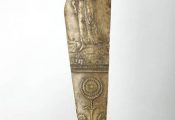
Ivory Tobacco Rasp, 1600s
During the 1600s London merchants were primarily interested in importing gold and ivory from West Africa. This carved ivory rasp was used for shredding tobacco leaves, another...
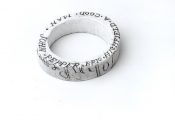
Ivory trade token
This is possibly an ivory trade token, 133 mm in diameter, and inscribed ‘John Pepper Brig Highfield, A Good Man’. The significance of trade tokens is yet to be...

King Manilla
This is a very large type of brass manilla, made in Africa for use as a form of wealth and in funeral ceremonies. Manillas became a form of currency in West Africa from the 16th...

Mask of the Sande Society from the Mende of Sierra Leone
The Sande mask from Sierra Leone is the only mask used by women in dances in Africa: most societies only have masks to be worn by men. This wooden mask represents the ideal of...

Small drum
This is a small drum, from Akim, Accra, Ghana. It measures 140 mm wide x 340 mm deep. Drums were an important part of African rituals, ceremonies and musical traditions, and...

Small drum with stick
This drum is from the Asante people of Ghana and is 535mm long. It is an instrument made of wood and hide. It was played with a drum stick on one end. Squeezing the strings under...
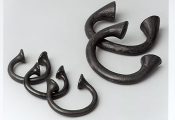
Small Manillas
These are small manillas made of a copper alloy and dating from the 18th or 19th century. Manillas became used as forms of currency, especially in the Niger Delta area of West...
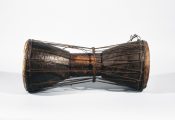
'Talking' drum from the Asante of Ghana
This drum is from the Asante people of Ghana and is 535 mm long. It is a musical instrument made of wood and hide. It was played with a drum stick on one end. Squeezing the strings...

Welt River Harp
This musical instrument, not very different from simple European versions, is made of wood, calabash and hide with a carved head. It is from the Welt River region of the Congo,...
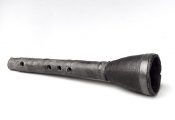
Wooden Oboe or Algiata, Northern Nigeria
This wooden oboe has four holes and a tin and reed mouthpiece. It is a wind instrument (aerophone). Similar instruments that are played by blowing were used widely throughout West...
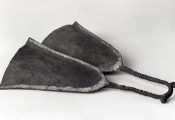
Wrought Iron Gong
This gong made of two flattened bell shapes joined at the top and edges is made of wrought iron. It comes from Calabar, Nigeria, West Africa.
Trade and Commerce

Painting of Billy Waters, 1815
This painting is of Billy Waters, an actor and musician who lived in London in the late 18th and early 19th centuries. It is believed to have been painted by the artist Sir David...
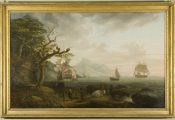
A View of Nevis from St. Kitts
The painting hangs in the drawing room of Bristol’s Georgian House. It is likely to have been commissioned by John Pinney, who built the house in 1790. Pinney was a wealthy...
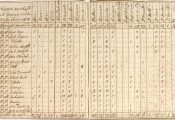
Account book for the Snow, Molly, a slave ship
This account book records details of enslaved Africans purchased at Bonny, in the Bight of Biafra, for voyage to the Caribbean. The Molly set sail from Bristol in 1758 and was...
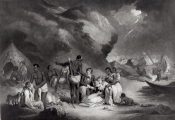
'African hospitality'
‘African Hospitality’ is a print by a celebrated engraver, John Raphael Smith (1752 – 1812), after a painting by his brother-in-law, the artist George Morland....

Beads
These are strings of pink and white beads. Glass beads were a regular cargo from England to Africa. In the 1770s they made up between 25% and 50% of the value of cargoes shipped by...

Bunce Island, Sierra Leone
This is a watercolour drawing from around 1805. It shows the slave fort on Bunce Island at the mouth of the Sierra Leone River in West Africa. The Royal Africa Company first...

Ceremonial Headdress
These ceremonial headdresses are from the Konkomba people in Ghana, and date from the early 20th century. Cowrie shells, imported from the Indian Ocean, were widely used throughout...

Chocolate pot, c1760
This pot was produced by the Bow porcelain factory. Chocolate was introduced to London as ‘the West Indian Drink Chocolate’ around 1650, and chocolate drinking...

Cowrie-shell belt
This belt from the Congo region of Africa is made from cowrie shells. They are the shells of a mollusc found only in certain areas around the Maldives and other Indian Ocean...
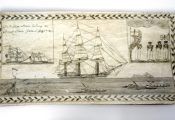
Curved plaque made from decorated whale jawbone
Curved plaque made from decorated whale jawbone decorated in Scrimshaw with the inscription, ‘HM Sloop Acorn capturing the Spanish Slaver Gabriel July 6th 1841’....
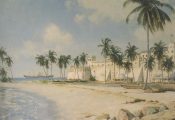
'Daru off Elmina Castle'
This oil painting is called ‘Daru off Elmina Castle’ and was painted in 1958 by John Stobart. Elmina is a castle or fort built by the Portuguese as a trading base in 1482 on...
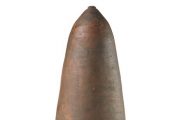
Earthenware sugar loaf mould, c1670
After the sugar cane was crushed, the sucrose solution was poured into moulds and allowed to set. A small hole in the bottom of the cone allowed the escape of a sticky, sweet...
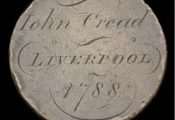
Engraved commemorative coin, the Amacree, 1788
This bronze commemorative coin from 1788 is engraved with the words ‘John Cread Liverpool’ on one side and ‘Success to the Amacree’ on the other side. The Amacree was...

Georgian House - Pantry
The Georgian House was built in 1790 for John Pinney, a wealthy slave plantation owner and sugar merchant. It was also where the enslaved African Pero lived, brought from...
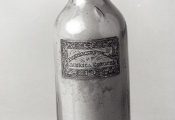
Glass Bottle
This 205-mm English glass bottle contained ginger powder, and dates from the early 19th century. Ginger was grown in the Caribbean and used widely in European kitchens. The bottle...
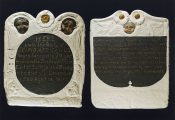
Gravestones of Scipio Africanus (copy)
Names of celebrated figures in history were often given to the enslaved as a form of ridicule. Scipio Africanus, the name of a celebrated Roman general, was given to a young...
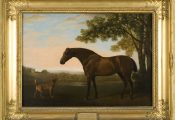
'Horse and Dog Trim'
George Stubbs (1724-1806) Oil on panel, 1783 Horse and Dog Trim was painted by George Stubbs, one of the greatest 18th century artists. Stubbs’ speciality was portraits of...

Ivory bracelet
This bracelet is a typical West African ornament made of elephant ivory. It is 101 mm in diameter, having been carved from a slice of elephant tusk. When the Portuguese and then...

Ivory trade token
This is possibly an ivory trade token, 133 mm in diameter, and inscribed ‘John Pepper Brig Highfield, A Good Man’. The significance of trade tokens is yet to be...

Job, son of Solliman Dgiallo, High Priest of Bonda in the Country of Foota, Africa
Ayuba Suleiman Diallo, who became known in Europe as Job ben Solomon, was from a prominent family of African Muslim religious leaders in the kingdom of Futa (in modern-day...

King Manilla
This is a very large type of brass manilla, made in Africa for use as a form of wealth and in funeral ceremonies. Manillas became a form of currency in West Africa from the 16th...
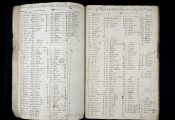
List of Negroes and Stock, Thomas Mill's plantation, 1750 & 1752
Every two years, an inventory of the plantation was drawn up. The fact that the enslaved labourers, children and livestock were all categories together is revealing. The lists...
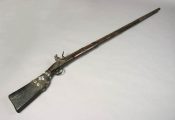
Musket
This flintlock musket was probably made for the British army and dates from the late 1700s. It was traded in Africa (probably for enslaved Africans) where guns were in great...
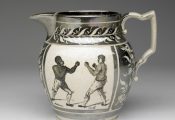
Pearlware jug depicting a boxing match
This jug shows a boxing match between Tom Molineaux and Tom Cribb in 1810. It was made in 1811. Tom Molineaux was born in 1784 as a slave in Virginia, America. He was trained by...
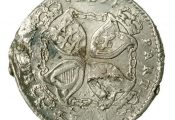
Plantation Token, 1688
During the reign of James II (1685 – 1689) the value of tin collapsed. To help rescue owners of mines in Britain from financial ruin the government began minting tin coins for...

'Portrait of Sir John Hawkins, (1532 - 95)'
This is a painting by an unknown artist of Sir John Hawkins, the man who made one of the first English slaving voyage to Africa in 1562, raiding villages to capture Africans....
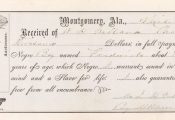
Receipt
This is the receipt for the purchase of an enslaved person by M. Harwell, auctioneer, Montgomery, Alabama, dated 5 April 1864, for $3000 in payment for ‘a Negro boy named...
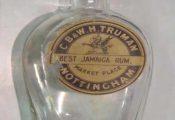
Rum bottle
Rum was one of the products manufactured on the plantations of the West Indies by slave labour. Rum was distilled as a by-product of sugar cane grown in the fields after the sugar...

Scene on the coast of Africa
This is an engraving of an oil painting, of African traders selling kidnapped people to the crew of a slave ship. Auguste-Francois Biard (1799 – 1882) painted the work in 1840,...
Caution historical and culturally sensitive image
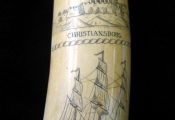
Scrimshaw Walrus tusk depicting European Slave fort
Scrimshaw takes the form of decorated pieces of whale tooth or baleen. Whalers would use a sail needle or other sharp instrument to scratch out pictures and messages. Ink, candle...
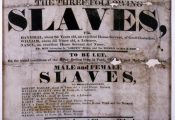
Slave sale poster, 1829
This is a poster from 1829 advertising a slave auction. Slaves were advertised and sold, along with other commodities, underlining the dehumanising nature of slavery. The slaves...
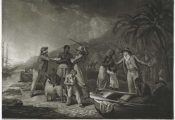
'Slave Trade, 1791'
Engraving by JR Smith after a painting by G Morland, 1788 Morland’s painting was produced and then distributed as a print, in support of the abolition campaign. It is a...

Small Manillas
These are small manillas made of a copper alloy and dating from the 18th or 19th century. Manillas became used as forms of currency, especially in the Niger Delta area of West...
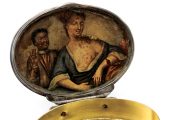
Snuffbox, c.1740
This object is a small silver box, from around 1740, for snuff (powdered tobacco), which was inhaled through the nose from a ‘pinch’ taken from the box between the thumb and...
Caution historical and culturally sensitive image
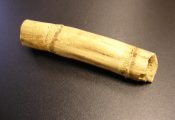
Sugar Cane
Sugar cane is a member of the grass family but the stalks can grow up to six metres tall and are extremely tough. Sugar cane grows best in warm tropical climates and was probably...

Sugar Crushing Mill, 1700s
Sugar cane production was back breaking work. Sugar cane was crushed soon after cutting, to extract the vital sucrose juice. Once harvest began, the work for the enslaved labourers...
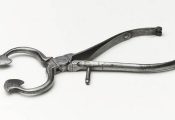
Sugar nippers
These sugar nippers date from around 1800. Steel sugar nippers were tools used for cutting off small pieces of sugar. Larger plain nippers were used in the kitchen and smaller...
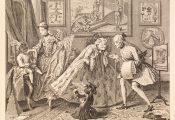
Taste in High Life
William Hogarth was one of the most important artists and caricaturists of the 18th century. In this domestic interior scene of a fashionable house, he has included a young African...
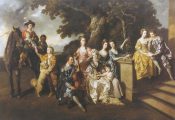
The family of Sir William Young
This oil painting dates from 1766 and shows the family of Sir William Young. Young was one of the most prominent and effective pro-slavery campaigners in the House of Commons. He...

The Georgian House - Exterior
The Georgian House was built in 1790 for John Pinney (architect William Paty), a wealthy slave plantation owner and sugar merchant. It was also where the enslaved African Pero...
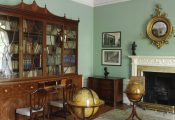
The Georgian House - Library
The Georgian House was built in 1790 for John Pinney (architect William Paty), a wealthy slave plantation owner and sugar merchant. It was also where the enslaved African Pero...
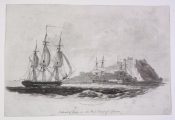
The Island of Goree, 1806
Situated off Senegal on the west coast of Africa, the island of Goree was one of the earliest slave trading factories. It was owned at different times by the English, French and...
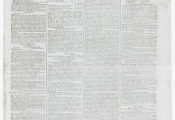
The Sun Newspaper, 15 December 1800
While the profits from the slave plantations could be enormous, the plantations also suffered considerably as a result of adverse weather, fluctuating prices at home, and war. The...
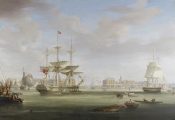
The Thomas King entering London Docks, 1827, by William John Huggins (1781-1845)
This painting shows the West Indiaman Thomas King entering the London Docks. The Thomas King, a Thames built ship, carried sugar and rum from Demerara, British Guiana. It was named...
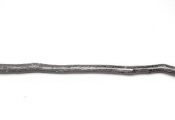
Yoke
Forked wooden sticks or yokes were used to tie captives together in a line or coffle when they were marched to the coast. The forked end was placed around a captive’s neck and...
Atlantic Crossing

Account book for the Snow, Molly, a slave ship
This account book records details of enslaved Africans purchased at Bonny, in the Bight of Biafra, for voyage to the Caribbean. The Molly set sail from Bristol in 1758 and was...
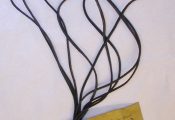
'Cat o'nine tails'
A cat o’nine tails is a whip with nine knotted lashes. Its origin is believed to date back to ancient Egypt, where the domestic cat was sacred and, even then, was said to...

'Daru off Elmina Castle'
This oil painting is called ‘Daru off Elmina Castle’ and was painted in 1958 by John Stobart. Elmina is a castle or fort built by the Portuguese as a trading base in 1482 on...
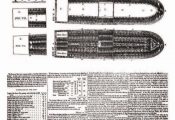
Description of a slave ship, c.1788
This is a print showing how Africans were packed into the slave ship Brookes, with text recording the dimensions and amount of space available. It was commissioned by Thomas...

HM Brig 'Acorn', 16 guns, in chase of the piratical slaver 'Gabriel', 1841
The Royal Navy’s West Africa Squadron was established in 1808. It was based in Sierra Leone, and its main job was to suppress illegal slave trading by British citizens. It...
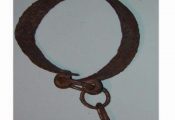
Iron neck ring
This iron neck ring and chains would have been worn by restrained African captives, either as they were transported to the West African coast or on board ship. The chains would...

Model of the Brookes, slave ship
This is a wooden model of the Brookes, owned by a Liverpool family, which carried slaves from the West coast of Africa to Jamaica in the West Indies. Two models of the ship were...

Punishment collar
Africans resisted enslavement from the point of capture. When enslaved people tried to run away after being captured by the slave traders, this heavy iron collar was placed on them...

Rum bottle
Rum was one of the products manufactured on the plantations of the West Indies by slave labour. Rum was distilled as a by-product of sugar cane grown in the fields after the sugar...
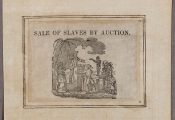
'Sale of slaves by auction'
This print from 1787 shows how Africans were sold when they arrived in the Americas. A child standing on the platform has just been sold to the European approaching the...

'Separation of families'
This print, published in 1787, shows individuals on the plantations being forcibly separated from family or friends. Repeated separation from the time of capture in Africa to being...
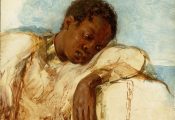
'Slave in Chains'
This oil painting is by an unidentified British artist and dates from between 1820 and 1850. It shows a young African man, little more than a boy, in a brass neck collar and with...

Slave sale poster, 1829
This is a poster from 1829 advertising a slave auction. Slaves were advertised and sold, along with other commodities, underlining the dehumanising nature of slavery. The slaves...
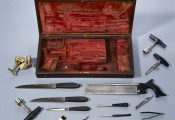
Surgical instrument set
This is a surgical instrument set and case by Whitford London, dating from the late 18th or early 19th century. Surgeons were carried on many slave ships. They were mostly involved...
Plantation Conditions
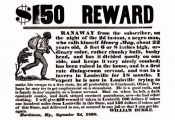
$150 Reward Poster
This is an American poster advertising a substantial reward for a runaway slave Henry May, in Louisville, Kentucky, 1838. The enslaved were seen as valuable commodities and the...

'A negro hung alive by the ribs to a gallows'
This engraving shows a man brutally hung up, while still alive, by a hook through his body. The print was used in John Gabriel Stedman’s Narrative of a Five Years’...
Caution historical and culturally sensitive image
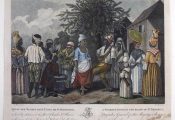
A Negroes Dance in the Island of St Dominica, 1773-1779
The Plantocracy frequently tried to suppress all vestiges of African culture, fearing that it could lead to a newly forged common identity among the enslaved – and therefore form...

Account book for the Snow, Molly, a slave ship
This account book records details of enslaved Africans purchased at Bonny, in the Bight of Biafra, for voyage to the Caribbean. The Molly set sail from Bristol in 1758 and was...

Branding iron
This is a replica of an early 19th century branding iron from America. It is not known whose initials, V S, are on the iron but it would have been used to mark African captives as...
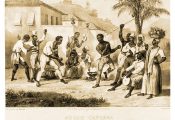
Capoeira Dance, Brazil, 1830s
Capoeira is a Brazilian martial arts-dance form whose origins are obscure: it may have originated in Africa or in the quarters of the enslaved on Brazilian plantations.
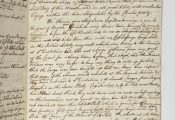
Copy letter to the Bristol slave trader, Michael Becher, June 23, 1753
The slave trade was a complex operation which relied upon the acquisition of intelligence from sources on all three points of the trading triangle. This letter from the plantation...
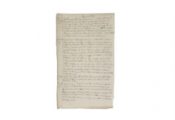
Daily Occurrences Book, Golden Rock Plantation, Nevis, 1776
The Occurrences book was kept by the Overseer and recorded the day-to-day activities on the plantation. It noted the size of the different work gangs, what they were doing, who was...
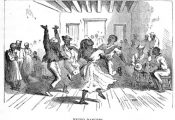
Dance or Festival, Havana, Cuba, ca. 1866
The author, who visited Cuba around 1866, writes of African-born enslaved people in Havana and their Sunday festivals. “And as all secret assemblies are against the law,...
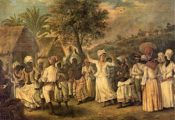
Dance, St. Vincent, West Indies, ca. 1775
This picture is entitled “Villagers Merry Making in the island of St. Vincent, with Dancers and Musicians, A Landscape with Huts on a Hill.” Romanticised houses for the...
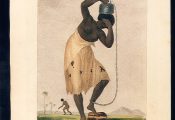
Female Negro Slave, with a weight chained to her ankle
This print of a ‘Female Negro Slave, With A Weight chained to her Ankle’ is from J.G. Steadman’s Narrative of a Five year Expedition against the Revolted Negroes...
Caution historical and culturally sensitive image
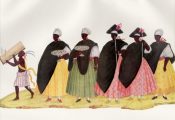
Festival of Our Lady of the Rosary, Rio de Janeiro, Brazil, ca. 1770s
Carlos Juliao, Riscos illuminados de figurinhos de broncos e negros dos uzos do Rio de Janeiro e Serro do Frio (Rio de Janeiro, 1960), plate 35. The prints used as plates in this...

Gravestones of Scipio Africanus (copy)
Names of celebrated figures in history were often given to the enslaved as a form of ridicule. Scipio Africanus, the name of a celebrated Roman general, was given to a young...

Handcuffs
Circa 1860M Iron, 7 ½ cm diameter, 7 ½ cm long chain Found in the cellar of an old plantation house (‘Woodlawn’) near Richmond, Virginia. These would have almost...

Iron neck ring
This iron neck ring and chains would have been worn by restrained African captives, either as they were transported to the West African coast or on board ship. The chains would...

John Canoe Dancers, Jamaica, 1837
The “Red Set-Girls, and Jack in the Green,” are led by their “Queen” and wear dresses of the same colour. Their jewellery is not as elaborate as the Queen’s, but they...
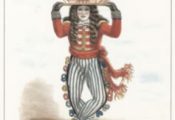
John Canoe (Jonkonnu, JonKanoo) Costume, Jamaica, 1837
Captioned, “Jaw-Bone, or House John-Canoe,” along with “Koo-Koo, or Actor Boy” this “is the most conspicuous of those who annually attract public notice.” He dresses in...

John Canoe (Jonkonnu, JonKanoo) Costume, Jamaica, 1838
Captioned “Koo, Koo, or Actor Boy,” this lithograph depicts an elaborately costumed and masked male dancer surrounded by on-lookers and musicians; he carries a whip and...
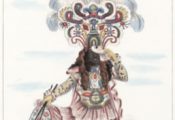
John Canoe (Jonkonnu, JonKanoo) Costume, Jamaica, 1838
Captioned, “Koo, Koo, or Actor-Boy,” John Canoe characters who, Belisario writes, were literate street performers who recited passages from, for example, Shakespeare plays and...
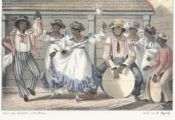
John Canoe (Jonkonnu, JonKanoo) Dancers, Jamaica
Captioned, “French Set-Girls,” Belisario traces their origin to African and Creole enslaved people who came to Jamaica with their owners, escaping the revolt in St. Dominque....
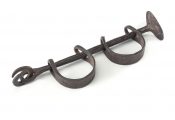
Leg Irons
These 19th century leg-irons were used to restrain the enslaved. The metal bar is turned and withdrawn and the two horseshoe-shaped rings fitted around the ankles. The bar is then...

List of Negroes and Stock, Thomas Mill's plantation, 1750 & 1752
Every two years, an inventory of the plantation was drawn up. The fact that the enslaved labourers, children and livestock were all categories together is revealing. The lists...
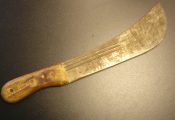
Machete
Machetes were essential for harvesting the sugar cane in America and the Caribbean, but they could become a deadly weapon during a slave rebellion. These tools symbolize the...
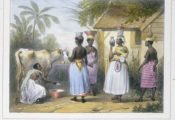
Milkmaid and Milk Sellers, Surinam, 1839
Milk and milk products, the author explains, are provided by elderly “missies” (usually free Black women and former mistresses of White men) who own cows. These women...

Nancy Burns' Headscarf
ca. 1844, New York Cotton. 33 ½ cm x 15 cm The headscarf originated in Sub-Sahara Africa. The ‘wrap’ or scarf varied from region to region and signified a communal...

'Negroes Sunday Market at Antigua'
This etching dates from 1806 and shows a Sunday market run by the enslaved in Antigua. Slaves had little control over their lives but they were sometimes able to shape and improve...
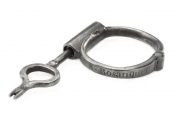
Ownership Manacle (lock and key)
Instruments of torture and punishment were often used to instil fear on plantations. This metal band would be locked onto an enslaved person’s wrist to show they were...
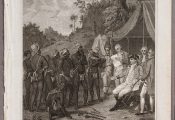
'Pacification with the Maroon Negroes'
This is an 1801 engraving by Agostino Brunyas. The Maroons were self liberated slaves in Jamaica who fought the British to retain their independence. At the end of the first Maroon...

Pearlware jug depicting a boxing match
This jug shows a boxing match between Tom Molineaux and Tom Cribb in 1810. It was made in 1811. Tom Molineaux was born in 1784 as a slave in Virginia, America. He was trained by...
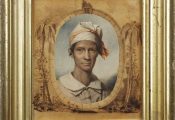
Portrait of Nancy Burns
Ferdinand Thomas Lee Boyle (1820 – 1906) Circa 1844, New York Watercolour, 19 cm x 17 ¾ cm Nancy Burns (1800 – 1849), the daughter of slaves, was born near Albany New York....

Punishment collar
Africans resisted enslavement from the point of capture. When enslaved people tried to run away after being captured by the slave traders, this heavy iron collar was placed on them...
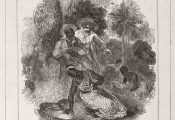
'Rosa ordered to be flogged'
This wood engraving shows an artist’s impression of a real example of the brutality of slavery, when a pregnant woman was beaten in Berbice, Guyana, in 1825. Rosa was picking...
Caution historical and culturally sensitive image
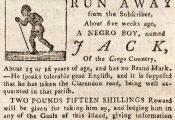
'Run away... Jack' advertisement
This advertisement was printed in the ‘Jamaica Mercury and Kingston Weekly Advertiser’, 1779. It offers a reward for the return of a runaway, a young boy called Jack....

'Sale of slaves by auction'
This print from 1787 shows how Africans were sold when they arrived in the Americas. A child standing on the platform has just been sold to the European approaching the...

'Separation of families'
This print, published in 1787, shows individuals on the plantations being forcibly separated from family or friends. Repeated separation from the time of capture in Africa to being...
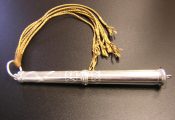
Silver whip
This whip made of chased silver and leather was owned by a lady and would have been used to punish domestic slaves for minor transgressions in their work. The enslaved were also...
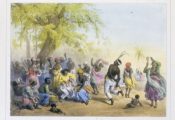
Slave Festival, Surinam, 1839
Caption, “Le Dou, ou grande fete des esclaves” (The Dou or great festival of the slaves). According to Benoit, the Dou “is ordinarily danced by the [freed Blacks]...

Slave sale poster, 1829
This is a poster from 1829 advertising a slave auction. Slaves were advertised and sold, along with other commodities, underlining the dehumanising nature of slavery. The slaves...
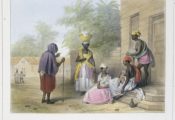
Slaves Conversing, Paramaribo, Surinam, 1839
Pierre Jacques Benoit, Voyage a Surinam . . . cent dessins pris sur nature par l’auteur (Bruxelles, 1839), plate xlii, fig. 88. (Copy in the John Carter Brown Library at...

Slaves Fighting, Brazil, ca. 1820-24
Painted by Augustus Earle (1793-1838); original in National Library of Australia, Canberra (nla.pic-an2822650) This picture is Water colour on paper and is entitled “Negroes...

Small drum
This is a small drum, from Akim, Accra, Ghana. It measures 140 mm wide x 340 mm deep. Drums were an important part of African rituals, ceremonies and musical traditions, and...
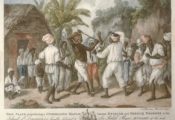
Stick Fighting, Dominica, West Indies, 1779
The text under the picture reads “This plate (representing a cudgelling match between English and French…[slaves] in the island of Dominica) is humbly...

Sugar Cane
Sugar cane is a member of the grass family but the stalks can grow up to six metres tall and are extremely tough. Sugar cane grows best in warm tropical climates and was probably...
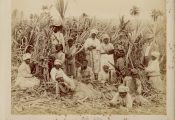
Sugar cane cutters in Jamaica, Caribbean
This photograph shows workers cutting cane in about 1880. The workers are made to pose to depict a seemingly happy natural scene, taking a break from their work. Some are...

Sugar Crushing Mill, 1700s
Sugar cane production was back breaking work. Sugar cane was crushed soon after cutting, to extract the vital sucrose juice. Once harvest began, the work for the enslaved labourers...

'Talking' drum from the Asante of Ghana
This drum is from the Asante people of Ghana and is 535 mm long. It is a musical instrument made of wood and hide. It was played with a drum stick on one end. Squeezing the strings...

The family of Sir William Young
This oil painting dates from 1766 and shows the family of Sir William Young. Young was one of the most prominent and effective pro-slavery campaigners in the House of Commons. He...

The Georgian House - Exterior
The Georgian House was built in 1790 for John Pinney (architect William Paty), a wealthy slave plantation owner and sugar merchant. It was also where the enslaved African Pero...

The Georgian House - Library
The Georgian House was built in 1790 for John Pinney (architect William Paty), a wealthy slave plantation owner and sugar merchant. It was also where the enslaved African Pero...

The Sun Newspaper, 15 December 1800
While the profits from the slave plantations could be enormous, the plantations also suffered considerably as a result of adverse weather, fluctuating prices at home, and war. The...
Resistance and Rebellion

$150 Reward Poster
This is an American poster advertising a substantial reward for a runaway slave Henry May, in Louisville, Kentucky, 1838. The enslaved were seen as valuable commodities and the...

'A negro hung alive by the ribs to a gallows'
This engraving shows a man brutally hung up, while still alive, by a hook through his body. The print was used in John Gabriel Stedman’s Narrative of a Five Years’...
Caution historical and culturally sensitive image

A Negroes Dance in the Island of St Dominica, 1773-1779
The Plantocracy frequently tried to suppress all vestiges of African culture, fearing that it could lead to a newly forged common identity among the enslaved – and therefore form...
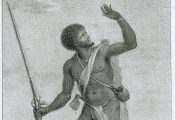
'A rebel negro armed and on his guard'
This print is from 1796 and was used in John Gabriel Stedman’s Narrative of a Five Years’ Expedition Against the Revolted Negroes of Surinam. The account describes a...
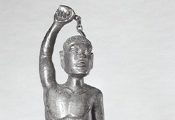
Carved wooden figure
This figure is of an enslaved African breaking free of his chains in what may be seen as a symbolic gesture. Carved from wood, it is from America and dates from the late 19th...

Handcuffs
Circa 1860M Iron, 7 ½ cm diameter, 7 ½ cm long chain Found in the cellar of an old plantation house (‘Woodlawn’) near Richmond, Virginia. These would have almost...

'Horse and Dog Trim'
George Stubbs (1724-1806) Oil on panel, 1783 Horse and Dog Trim was painted by George Stubbs, one of the greatest 18th century artists. Stubbs’ speciality was portraits of...
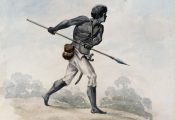
Leonard Parkinson, captain of the Maroons
This is a watercolour of 1796 by H. Smith and is probably copied from a well known print. It is one of very few images drawn from life of the enslaved from the time of the slave...

Machete
Machetes were essential for harvesting the sugar cane in America and the Caribbean, but they could become a deadly weapon during a slave rebellion. These tools symbolize the...

Nancy Burns' Headscarf
ca. 1844, New York Cotton. 33 ½ cm x 15 cm The headscarf originated in Sub-Sahara Africa. The ‘wrap’ or scarf varied from region to region and signified a communal...

Ownership Manacle (lock and key)
Instruments of torture and punishment were often used to instil fear on plantations. This metal band would be locked onto an enslaved person’s wrist to show they were...

'Pacification with the Maroon Negroes'
This is an 1801 engraving by Agostino Brunyas. The Maroons were self liberated slaves in Jamaica who fought the British to retain their independence. At the end of the first Maroon...

Portrait of Nancy Burns
Ferdinand Thomas Lee Boyle (1820 – 1906) Circa 1844, New York Watercolour, 19 cm x 17 ¾ cm Nancy Burns (1800 – 1849), the daughter of slaves, was born near Albany New York....

Punishment collar
Africans resisted enslavement from the point of capture. When enslaved people tried to run away after being captured by the slave traders, this heavy iron collar was placed on them...

'Run away... Jack' advertisement
This advertisement was printed in the ‘Jamaica Mercury and Kingston Weekly Advertiser’, 1779. It offers a reward for the return of a runaway, a young boy called Jack....

Small drum
This is a small drum, from Akim, Accra, Ghana. It measures 140 mm wide x 340 mm deep. Drums were an important part of African rituals, ceremonies and musical traditions, and...

'Talking' drum from the Asante of Ghana
This drum is from the Asante people of Ghana and is 535 mm long. It is a musical instrument made of wood and hide. It was played with a drum stick on one end. Squeezing the strings...
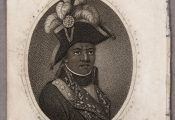
Toussaint L'Ouverture, Chief of the French Rebels in St. Domingue
Toussaint L’Ouverture was born a slave, became an overseer and was finally freed. Toussaint became the leader of rebel slaves in St. Domingue and orchestrated the first...
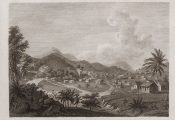
'Trelawny Town, the chief residence of the Maroons'
This etching was made by an unknown artist in around 1800. The Maroons were communities of escaped slaves who lived in the mountain areas of Jamaica. This etching was published in...
The Campaign for Abolition
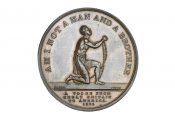
Abolition Campaign medallion
British abolitionists celebrated their victory by issuing a series of commemorative medallions. The example shown here offers a challenge to the people of America, but others...

Abolition campaign Sugar bowl, 1825
This sugar bowl is decorated with an adaptation of the campaign logo. Wedgewood’s original design featured an enslaved man. The later image of a woman reflected the growing...
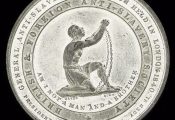
Abolition commemorative token
A silver version of the ‘Am I not a Man and a Brother?’ logo reproduced on a commemorative token. Token coinage was issued by traders and manufacturers to cope with a...
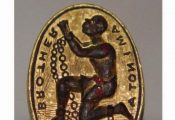
Abolition Seal
This abolition seal was adopted by the Committee for the Abolition of the Slave Trade on 16 October 1787. The seal depicts the symbol of the kneeling slave in chains with the motto...
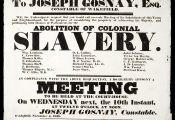
Advertising Bill for Abolition
This advertising bill, or poster, announces a public meeting to be held by the Constable, Joseph Gosnay, on 10 November 1830 in Wakefield, Yorkshire. The people of Wakefield are...
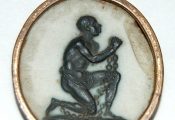
Anti-slavery Jasperware medallion
Josiah Wedgwood was involved with many leading anti-slavery supporters, including William Wilberforce and Thomas Clarkson. In order to moblise popular public support for the...
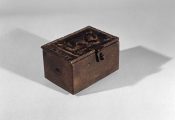
Box, possibly for tobacco
The use of the abolitionist logo of a chained, kneeling slave shown pleading to Europeans to give him his freedom was widely encouraged. The image suited the religious and moral...
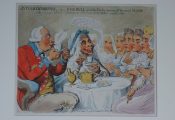
Charicature by James Gillray
ANTI-SACCHARRITES, or JOHN BULL and his family leaving off the use of SUGAR Charicature by James Gillray (1757-1815) Etching on paper, 1792 This is 18th century political satirist...

Curved plaque made from decorated whale jawbone
Curved plaque made from decorated whale jawbone decorated in Scrimshaw with the inscription, ‘HM Sloop Acorn capturing the Spanish Slaver Gabriel July 6th 1841’....

Description of a slave ship, c.1788
This is a print showing how Africans were packed into the slave ship Brookes, with text recording the dimensions and amount of space available. It was commissioned by Thomas...
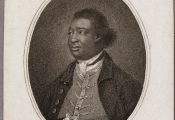
Frontis-piece of Ignatius Sancho
This frontis-piece is after a portrait of Ignatius Sancho that was painted by his friend, the famous artist Thomas Gainsborough, in Bath in 1768. Ignatius Sancho was the first...
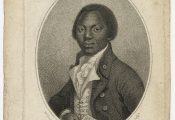
Frontis-piece of Olaudah Equiano
It is often thought that Africans sold into slavery had little or no voice in the political campaign against it. However, there were a number of people in British society who had...

Gravestones of Scipio Africanus (copy)
Names of celebrated figures in history were often given to the enslaved as a form of ridicule. Scipio Africanus, the name of a celebrated Roman general, was given to a young...
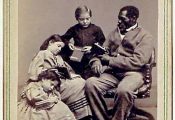
Learning is Wealth
Learning is Wealth. Wilson, Charley, Rebecca & Rosa. Slaves from New Orleans. Charles Paxson (photographer) 1859 – 1865, New York Carte de visite, 10 cm x 6 cm Inscribed on...
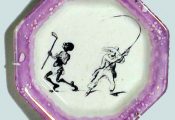
Octagonal Transferware Plate
Circa 1860, Staffordshire Transfer printed ceramic, 11 ½ cm diameter Staffordshire plate with transfer print featuring the cruel plantation owner, Simon Legree, from Harriet...
Caution historical and culturally sensitive image

'Pacification with the Maroon Negroes'
This is an 1801 engraving by Agostino Brunyas. The Maroons were self liberated slaves in Jamaica who fought the British to retain their independence. At the end of the first Maroon...
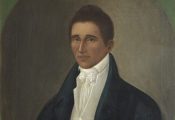
Portrait of a Gentleman
Joshua Johnson (circa 1765 – 1830) 1796 – 1824, Baltimore Maryland Oil on canvas, 68 cm x 58 cm Born into slavery, Joshua Johnson had received his freedom by 1796, when he...
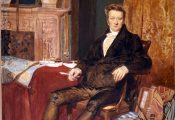
Portrait of Thomas Clarkson (1760 - 1846)
Thomas Clarkson was a key campaigner for the abolition of the slave trade and gathered evidence and witnesses for the cause, particularly from sailors. This evidence was used in...
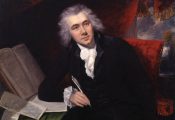
Portrait of William Wilberforce (1759 - 1833)
William Wilberforce (1759-1833) was a Member of Parliament for Hull and later Yorkshire. His many causes included the reformation of manners amongst the gentry, but his most famous...

'Rosa ordered to be flogged'
This wood engraving shows an artist’s impression of a real example of the brutality of slavery, when a pregnant woman was beaten in Berbice, Guyana, in 1825. Rosa was picking...
Caution historical and culturally sensitive image
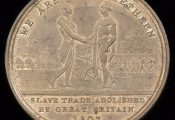
Slave Trade Abolished by Great Britain, 1807, medal
Medals carrying anti-slavery mottos and images were widely reproduced and distributed to celebrate the success of the abolitionist campaigns. This bronze medal shows an African and...
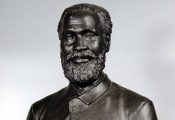
Spelter bust of Uncle Tom
W. Charles May 1876, London Painted cast metal, 48 cm high Painted cast metal bust of ‘Uncle Tom’ who was in real life the Reverend Josiah Henson. On the base of the...
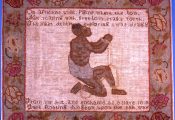
Tapestry, 19th century
Women could not be elected to public office to become Members of Parliament or vote in political elections, but they made their views public in many different ways. Women boycotted...
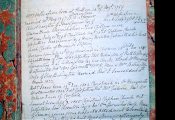
Wilberforce family Bible
This Bible was held in the family of William Wilberforce until the twentieth century. Inside the cover it contains a handwritten family tree in which Wilberforce’s birth is...
Emancipation
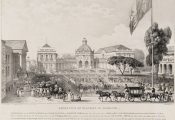
Abolition of slavery in Jamaica
This image was produced by Thomas Picken (1815-70), and was published by R. Cartwright, London in 1838. It shows the Governor of Jamaica, Sir Lionel Smith (1778-1842) on the steps...
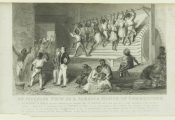
An interior view of a Jamaica house of correction'
This is a steel engraving of people being punished in a ‘house of correction’ in Jamaica in 1837. This print dates from the point at which slavery had been abolished....
Caution historical and culturally sensitive image

Anti-slavery Jasperware medallion
Josiah Wedgwood was involved with many leading anti-slavery supporters, including William Wilberforce and Thomas Clarkson. In order to moblise popular public support for the...

Bunce Island, Sierra Leone
This is a watercolour drawing from around 1805. It shows the slave fort on Bunce Island at the mouth of the Sierra Leone River in West Africa. The Royal Africa Company first...
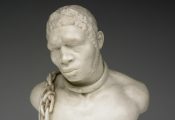
Bust of an enslaved African in chains, manufactured by W.T. Copeland, after 1847
Bust of an enslaved African in chains, stamped COPELAND on the reverse, manufactured by W.T. Copeland, after 1847. This sculpture of an enslaved African was made at least 14 years...

Carved wooden figure
This figure is of an enslaved African breaking free of his chains in what may be seen as a symbolic gesture. Carved from wood, it is from America and dates from the late 19th...

Dance, St. Vincent, West Indies, ca. 1775
This picture is entitled “Villagers Merry Making in the island of St. Vincent, with Dancers and Musicians, A Landscape with Huts on a Hill.” Romanticised houses for the...
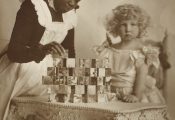
De'Ah, a maid, about 1900
This photograph was taken in 1900c., over 60 years after slavery was abolished in the British Empire, and 35 years after Emancipation in the United States. The photo shows a maid...

Gravestones of Scipio Africanus (copy)
Names of celebrated figures in history were often given to the enslaved as a form of ridicule. Scipio Africanus, the name of a celebrated Roman general, was given to a young...

HM Brig 'Acorn', 16 guns, in chase of the piratical slaver 'Gabriel', 1841
The Royal Navy’s West Africa Squadron was established in 1808. It was based in Sierra Leone, and its main job was to suppress illegal slave trading by British citizens. It...

John Canoe (Jonkonnu, JonKanoo) Dancers, Jamaica
Captioned, “French Set-Girls,” Belisario traces their origin to African and Creole enslaved people who came to Jamaica with their owners, escaping the revolt in St. Dominque....

Learning is Wealth
Learning is Wealth. Wilson, Charley, Rebecca & Rosa. Slaves from New Orleans. Charles Paxson (photographer) 1859 – 1865, New York Carte de visite, 10 cm x 6 cm Inscribed on...

Nancy Burns' Headscarf
ca. 1844, New York Cotton. 33 ½ cm x 15 cm The headscarf originated in Sub-Sahara Africa. The ‘wrap’ or scarf varied from region to region and signified a communal...
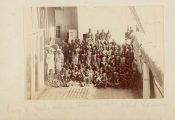
Newly released captives on board HMS London
This photograph shows a group of African people enslaved as part of the East African trade. This group were freed from slavery by the Royal Navy in 1882. HMS London was the Royal...

Portrait of Nancy Burns
Ferdinand Thomas Lee Boyle (1820 – 1906) Circa 1844, New York Watercolour, 19 cm x 17 ¾ cm Nancy Burns (1800 – 1849), the daughter of slaves, was born near Albany New York....

Slave Festival, Surinam, 1839
Caption, “Le Dou, ou grande fete des esclaves” (The Dou or great festival of the slaves). According to Benoit, the Dou “is ordinarily danced by the [freed Blacks]...
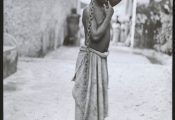
'Slavery in Zanzibar', about 1890
This is a photograph taken by a missionary and made into a glass lantern slide. It was given the title ‘Slavery in Zanzibar’, and was taken in around 1907, long after...
Caution historical and culturally sensitive image

Sugar cane cutters in Jamaica, Caribbean
This photograph shows workers cutting cane in about 1880. The workers are made to pose to depict a seemingly happy natural scene, taking a break from their work. Some are...

To the friends of Negro emancipation
This image was produced by the engraver David Lucas (1802 – 81) from a painting by Alexander Rippingille, and was published by Francis Graham Moon (1796 – 1871) London, in...
Legacies

An interior view of a Jamaica house of correction'
This is a steel engraving of people being punished in a ‘house of correction’ in Jamaica in 1837. This print dates from the point at which slavery had been abolished....
Caution historical and culturally sensitive image

Bust of an enslaved African in chains, manufactured by W.T. Copeland, after 1847
Bust of an enslaved African in chains, stamped COPELAND on the reverse, manufactured by W.T. Copeland, after 1847. This sculpture of an enslaved African was made at least 14 years...
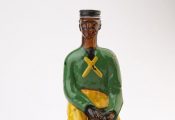
Calypso Rum bottle, about 1970
This bottle was produced for rum distilled at the Hopefield Sugar Plantation in Barbados. The Hopefield Plantation is one of the oldest surviving sugar plantations on the island...

Capoeira Dance, Brazil, 1830s
Capoeira is a Brazilian martial arts-dance form whose origins are obscure: it may have originated in Africa or in the quarters of the enslaved on Brazilian plantations.
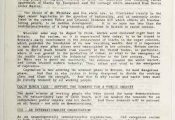
Caribbean Labour solidarity newsletter, 1983
Caribbean Labour Solidarity was founded in the 1960s in north London. An international campaigning organisation, it drew attention to the links between modern racism and...

Dance or Festival, Havana, Cuba, ca. 1866
The author, who visited Cuba around 1866, writes of African-born enslaved people in Havana and their Sunday festivals. “And as all secret assemblies are against the law,...

De'Ah, a maid, about 1900
This photograph was taken in 1900c., over 60 years after slavery was abolished in the British Empire, and 35 years after Emancipation in the United States. The photo shows a maid...

John Canoe Dancers, Jamaica, 1837
The “Red Set-Girls, and Jack in the Green,” are led by their “Queen” and wear dresses of the same colour. Their jewellery is not as elaborate as the Queen’s, but they...

John Canoe (Jonkonnu, JonKanoo) Costume, Jamaica, 1837
Captioned, “Jaw-Bone, or House John-Canoe,” along with “Koo-Koo, or Actor Boy” this “is the most conspicuous of those who annually attract public notice.” He dresses in...

John Canoe (Jonkonnu, JonKanoo) Costume, Jamaica, 1838
Captioned “Koo, Koo, or Actor Boy,” this lithograph depicts an elaborately costumed and masked male dancer surrounded by on-lookers and musicians; he carries a whip and...

John Canoe (Jonkonnu, JonKanoo) Costume, Jamaica, 1838
Captioned, “Koo, Koo, or Actor-Boy,” John Canoe characters who, Belisario writes, were literate street performers who recited passages from, for example, Shakespeare plays and...

John Canoe (Jonkonnu, JonKanoo) Dancers, Jamaica
Captioned, “French Set-Girls,” Belisario traces their origin to African and Creole enslaved people who came to Jamaica with their owners, escaping the revolt in St. Dominque....
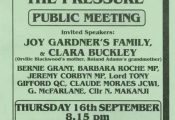
Joy Gardner Campaign handbill, 1993
Jamaican born Joy Gardner was 40 when she died after police gagged her when they arrived at her flat to deport her. Her son, who was five years old at the time, watched her die. In...
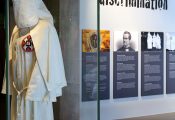
Ku Klux Klan Costume
The Ku Klux Klan is a racist group. Although there have always been different branches, all have a common goal: to maintain the supremacy of the White race over Black people. While...
Caution historical and culturally sensitive image

Milkmaid and Milk Sellers, Surinam, 1839
Milk and milk products, the author explains, are provided by elderly “missies” (usually free Black women and former mistresses of White men) who own cows. These women...

Newly released captives on board HMS London
This photograph shows a group of African people enslaved as part of the East African trade. This group were freed from slavery by the Royal Navy in 1882. HMS London was the Royal...
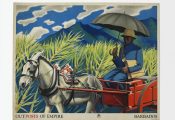
Outposts of Empire: Barbados. By John Vickery, 1937
In the 1930s Britain’s General Post Office commissioned a series of posters intended to celebrate the extent of their services throughout the Empire. Perhaps ironically, the...

Portrait of a Gentleman
Joshua Johnson (circa 1765 – 1830) 1796 – 1824, Baltimore Maryland Oil on canvas, 68 cm x 58 cm Born into slavery, Joshua Johnson had received his freedom by 1796, when he...
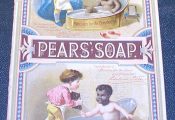
Racist advert for Pear's soap
Adverts like this for Pear’s soap, exploiting the differences between Black and White, are seen as explicitly racist today. They reinforce the stereotype of Black skin as...
Caution historical and culturally sensitive image
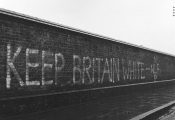
Racist graffiti on a brick wall, 1957-60, photograph by Henry Grant
The NLP was a short-lived racist organisation which later became the British National Party. The NLP, which campaigned primarily against immigration, called itself National Labour...
Caution historical and culturally sensitive image

Racist sticker produced by the British Movement, 1976
The British Movement was a racist organisation which existed between 1968-1983. Although small it was known for its violence against people of African and Asian origin, and...
Caution historical and culturally sensitive image
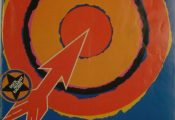
'Rock Against Racism' concert programme, c1978
Rock Against Racism was established in 1976 in response to racist pronouncements made by a number of rock musicians. The campaign used music to spread a powerful anti-racist...

Slave Festival, Surinam, 1839
Caption, “Le Dou, ou grande fete des esclaves” (The Dou or great festival of the slaves). According to Benoit, the Dou “is ordinarily danced by the [freed Blacks]...

'Slavery in Zanzibar', about 1890
This is a photograph taken by a missionary and made into a glass lantern slide. It was given the title ‘Slavery in Zanzibar’, and was taken in around 1907, long after...
Caution historical and culturally sensitive image

Slaves Fighting, Brazil, ca. 1820-24
Painted by Augustus Earle (1793-1838); original in National Library of Australia, Canberra (nla.pic-an2822650) This picture is Water colour on paper and is entitled “Negroes...

Stick Fighting, Dominica, West Indies, 1779
The text under the picture reads “This plate (representing a cudgelling match between English and French…[slaves] in the island of Dominica) is humbly...

Sugar cane cutters in Jamaica, Caribbean
This photograph shows workers cutting cane in about 1880. The workers are made to pose to depict a seemingly happy natural scene, taking a break from their work. Some are...

TUC book on racism in the workplace, 1983
Published by the Trades Union Congress Educational Trust, the book was produced to provide information about the origin of racism and the forms it could take in the workplace. It...
Diaspora

Painting of Billy Waters, 1815
This painting is of Billy Waters, an actor and musician who lived in London in the late 18th and early 19th centuries. It is believed to have been painted by the artist Sir David...

Caribbean Labour solidarity newsletter, 1983
Caribbean Labour Solidarity was founded in the 1960s in north London. An international campaigning organisation, it drew attention to the links between modern racism and...

Disabled plant seller, about 1800
Former slaves served in large numbers in Britain’s army and navy during both the American and the Napoleonic wars. At the end of the wars many made their way to London where...
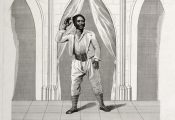
Engraving of Ira Aldridge
Engraving of Ira Aldridge, about 1820-30. by T Hollis, after William Paine. Ira Aldridge (1807 – 1867) was a leading Shakespearian actor who first appeared on the London...

Joy Gardner Campaign handbill, 1993
Jamaican born Joy Gardner was 40 when she died after police gagged her when they arrived at her flat to deport her. Her son, who was five years old at the time, watched her die. In...
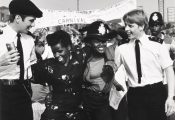
Policemen and revellers at the Notting Hill Carnival, 1990s
This photograph by Sydney Orleans Harding, records a convivial moment during the Notting Hill Carnival in the 1990s. London’s first Caribbean carnival took place in 1959. It...
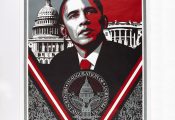
Poster of Barack Obama: 'Be The Change, January 20th 2009'
The Barack Obama ‘Be the Change’ official poster designed by the artist Shepard Fairey, was widely described as iconic and became synonymous with the 2008 Obama...

Racist graffiti on a brick wall, 1957-60, photograph by Henry Grant
The NLP was a short-lived racist organisation which later became the British National Party. The NLP, which campaigned primarily against immigration, called itself National Labour...
Caution historical and culturally sensitive image

'Rock Against Racism' concert programme, c1978
Rock Against Racism was established in 1976 in response to racist pronouncements made by a number of rock musicians. The campaign used music to spread a powerful anti-racist...
